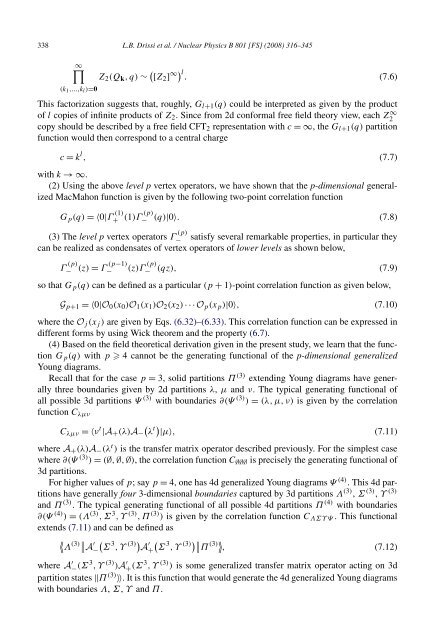Contributions à l'Etude du Vertex Topologique en Théorie ... - Toubkal
Contributions à l'Etude du Vertex Topologique en Théorie ... - Toubkal
Contributions à l'Etude du Vertex Topologique en Théorie ... - Toubkal
- No tags were found...
You also want an ePaper? Increase the reach of your titles
YUMPU automatically turns print PDFs into web optimized ePapers that Google loves.
338 L.B. Drissi et al. / Nuclear Physics B 801 [FS] (2008) 316–345∞∏(k 1 ,...,k l )=0Z 2 (Q k ,q)∼ ( [Z 2 ] ∞) l .This factorization suggests that, roughly, G l+1 (q) could be interpreted as giv<strong>en</strong> by the pro<strong>du</strong>ctof l copies of infinite pro<strong>du</strong>cts of Z 2 . Since from 2d conformal free field theory view, each Z ∞ 2copy should be described by a free field CFT 2 repres<strong>en</strong>tation with c =∞,theG l+1 (q) partitionfunction would th<strong>en</strong> correspond to a c<strong>en</strong>tral chargec = k l ,with k →∞.(2) Using the above level p vertex operators, we have shown that the p-dim<strong>en</strong>sional g<strong>en</strong>eralizedMacMahon function is giv<strong>en</strong> by the following two-point correlation functionG p (q) =〈0|Γ (1)+(p)(1)Γ − (q)|0〉.(3) The level p vertex operators Γ (p)− satisfy several remarkable properties, in particular theycan be realized as cond<strong>en</strong>sates of vertex operators of lower levels as shown below,Γ (p)−(z) = Γ(p−1)−(z)Γ (p)− (qz),so that G p (q) can be defined as a particular (p + 1)-point correlation function as giv<strong>en</strong> below,G p+1 =〈0|O 0 (x 0 )O 1 (x 1 )O 2 (x 2 ) ···O p (x p )|0〉,(7.6)(7.7)(7.8)(7.9)(7.10)where the O j (x j ) are giv<strong>en</strong> by Eqs. (6.32)–(6.33). This correlation function can be expressed indiffer<strong>en</strong>t forms by using Wick theorem and the property (6.7).(4) Based on the field theoretical derivation giv<strong>en</strong> in the pres<strong>en</strong>t study, we learn that the functionG p (q) with p 4 cannot be the g<strong>en</strong>erating functional of the p-dim<strong>en</strong>sional g<strong>en</strong>eralizedYoung diagrams.Recall that for the case p = 3, solid partitions Π (3) ext<strong>en</strong>ding Young diagrams have g<strong>en</strong>erallythree boundaries giv<strong>en</strong> by 2d partitions λ, μ and ν. The typical g<strong>en</strong>erating functional ofall possible 3d partitions Ψ (3) with boundaries ∂(Ψ (3) ) = (λ,μ,ν) is giv<strong>en</strong> by the correlationfunction C λμνC λμν =〈ν t (|A + (λ)A − λt ) |μ〉,(7.11)where A + (λ)A − (λ t ) is the transfer matrix operator described previously. For the simplest casewhere ∂(Ψ (3) ) = (∅, ∅, ∅), the correlation function C ∅∅∅ is precisely the g<strong>en</strong>erating functional of3d partitions.For higher values of p;sayp = 4, one has 4d g<strong>en</strong>eralized Young diagrams Ψ (4) . This 4d partitionshave g<strong>en</strong>erally four 3-dim<strong>en</strong>sional boundaries captured by 3d partitions Λ (3) , Σ (3) , Υ (3)and Π (3) . The typical g<strong>en</strong>erating functional of all possible 4d partitions Π (4) with boundaries∂(Ψ (4) ) = (Λ (3) ,Σ 3 ,Υ (3) ,Π (3) ) is giv<strong>en</strong> by the correlation function C ΛΣΥ Ψ . This functionalext<strong>en</strong>ds (7.11) and can be defined as〈〈Λ(3) ∥ ( A′− Σ 3 ,Υ (3)) A ′ (+ Σ 3 ,Υ (3))∥ ∥ Π(3) 〉〉 ,(7.12)where A ′ − (Σ3 ,Υ (3) )A ′ + (Σ3 ,Υ (3) ) is some g<strong>en</strong>eralized transfer matrix operator acting on 3dpartition states ‖Π (3) 〉〉. It is this function that would g<strong>en</strong>erate the 4d g<strong>en</strong>eralized Young diagramswith boundaries Λ, Σ, Υ and Π.

















